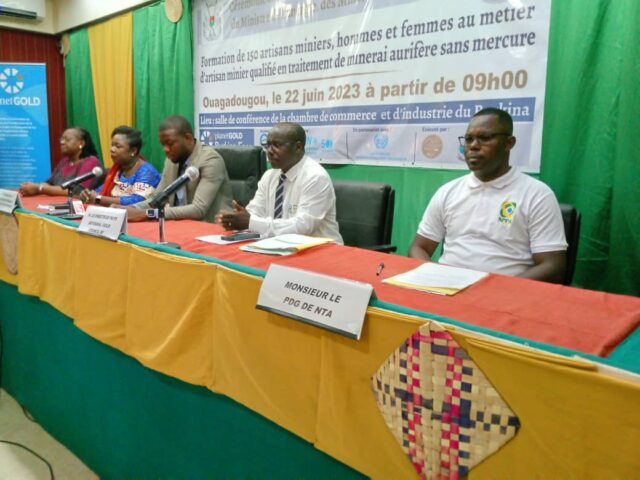- Through training for 150 artisanal miners
- In mercury-free ore processing technology
- With the gravimetric gold extraction method as an alternative
On Thursday 22 June 2023, the Ministry of Energy, Mines and Quarries, in partnership with New Applied Technologies (Nouvelles Technologies Appliquées, NTA) and the Artisanal Gold Council, officially launched the training of 150 artisanal miners in mercury-free ore processing technology in Ouagadougou. The launch ceremony was attended by many participants, including artisanal miners.
A project in line with the government’s vision
This training is part of the “Planet Gold Burkina Faso” project, supported by the Global Environment Facility (GEF), implemented by the United Nations Industrial Development Organisation (UNIDO) and run by the Artisanal Gold Council (AGC). This project has been running since 2019 with the aim of “Contributing to the elimination of the use of mercury in the supply chain of artisanal and small-scale gold mining operations in Burkina Faso”.
Component 3 of the project concerns : “Setting up a mercury-free ore processing unit and establishing a vocational training programme for mercury-free ore processing”.
This process has resulted in the introduction of two training standards for the trade of artisanal miner qualified in mercury-free technology, at the Basic Qualification Certificate (Certificat de Qualification de Base, CQB) level and Professional Qualification Certificate (Brevet de Qualification professionnelle, BQP) level. Out of 150 artisanal miners, 100 will be CQB level and 50 BQP level, with 40% women.
The training will take place in two phases: a theoretical phase in Ouagadougou and a second practical phase in the field.
Wendpanga Aimé Niongkouni, Managing Director of the National Agency for the Supervision of Artisanal and Semi-Mechanised Mining (Agence National d’Encadrement des Exploitations minières Artisanales et semi-mécanisées, ANEEMAS), representing the Minister of Energy, Mines and Quarries, officially launched the training course.
He added: “The project will help to provide semi-mechanised mining companies with the skills they need for their operations, which will considerably reduce if not eliminate the use of mercury in the artisanal gold production chain”.
He stressed that the objectives pursued by the project through this training programme are fully in line with the government’s vision of making the mining crafts sub-sector a lever for our country’s development.
Seydou Kabré, Country Director of the Artisanal Gold Council, pointed out at the training launch ceremony that artisanal mining has become the main source of mercury emissions into the environment, with a mercury/gold ratio of around 1.56g.
According to Yebo Waré, the promoter of new applied technologies, the use of mercury will be reduced by using the gravimetric method to extract the gold and allow the material to pass through.
Gravimetric gold extraction as an alternative
In alluvial placers, native gold is found in the form of gold flakes of varying sizes (millimetre-sized powder, flakes, grains or nuggets of gold) mixed with alluvial deposits. Gold panning and placer mining are based on a process of extracting gold by gravity separation. Historically, this technique was the most important means of extracting the native metal. In this case, water is used to separate the gold particles from the placer ores.
With the pan (or batée), you perform a controlled technical movement of rotation in the water. This exerts a hydraulic centrifugal force on the alluvium. In this way, the lighter alluvium is evacuated first and the denser material remains at the bottom of the pan. Finally, a second, more technical step separates the alluvium from the gold, once again using centrifugal inertia. This gold extraction technique has been automated with the use of a washing table or ramp, also known as a sluice.
Rachid Ouédraogo
#Mines_Actu_Burkina










